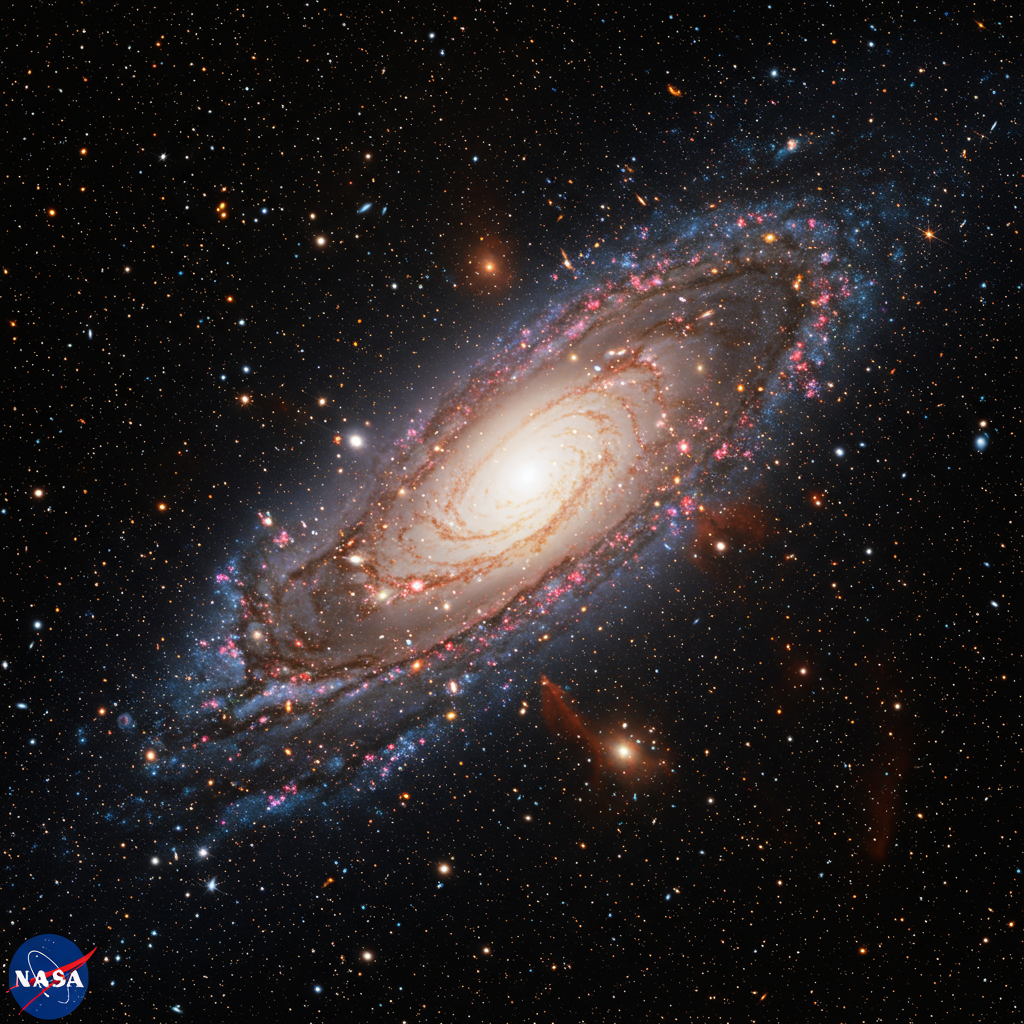Prepare to see the cosmos in a completely new light. NASA’s Spectro-Photometer for the History of the Universe, Epoch of Reionization, and Ices Explorer, mercifully known as spherex, is now actively mapping the entire night sky. This isn’t just any map; it’s an unprecedented infrared survey using 102 different “colors” of light invisible to human eyes. And perhaps the most exciting part? This vast dataset is slated for public release, granting scientists, students, and space enthusiasts alike access to remarkable insights into the universe’s deepest secrets.
What is the SPHEREx mission?
Launched in March 2025, SPHEREx is a new astrophysics space telescope developed by NASA. Operating from a low-Earth orbit, its primary mission is to create a comprehensive all-sky map. But SPHEREx goes beyond simple imaging. It utilizes spectroscopy, breaking down light from cosmic sources into its constituent wavelengths, much like a prism separates sunlight into a rainbow. This detailed spectral information allows scientists to identify the chemical composition and distance of distant objects.
The mission is designed to operate for 25 months, circling Earth over 11,000 times. It systematically scans the entire celestial sphere, covering a full map every six months. Over its lifespan, SPHEREx will build four complete maps of the cosmos, providing a temporal element to observe changes.
Why Map in Infrared Light?
Infrared light is crucial for peering into the universe’s hidden corners. Unlike visible light, which is easily blocked by interstellar dust and gas, infrared wavelengths can penetrate these cosmic veils. This capability allows SPHEREx to observe objects and phenomena that remain obscured in visible light surveys. By capturing light across 102 distinct infrared wavelengths, SPHEREx offers a far richer spectral view than previous infrared missions like NASA’s WISE, which used only four bands. This detailed “spectral fingerprinting” is key to unlocking new scientific understanding.
Unlocking Cosmic Secrets with Spectroscopy
The core strength of SPHEREx lies in its spectroscopic ability across so many wavelengths. Analyzing the precise combination of infrared light from a source reveals its unique spectral signature. This signature acts like a cosmic barcode, allowing scientists to identify specific molecules present. It also provides crucial data to determine the distances to millions of galaxies, enabling the creation of a detailed 3D map of the universe’s large-scale structure.
Each day, SPHEREx captures roughly 3,600 unique images through about 600 exposures. Light from each exposure passes through six detectors, each tuned to different infrared bands, generating a wealth of data points across the sky. This detailed data is essential for achieving the mission’s ambitious scientific goals.
SPHEREx’s Ambitious Science Goals
The SPHEREx mission aims to tackle some of the most fundamental questions in astrophysics. One major objective is to study the distribution of frozen water and organic molecules throughout the Milky Way galaxy. These molecules are considered essential building blocks for life. Mapping their presence in star-forming regions and around other planetary systems will help scientists understand how these crucial ingredients are spread across the galaxy and potentially delivered to new planets.
Beyond our galactic neighborhood, SPHEREx will investigate the period of rapid expansion known as cosmic inflation, theorized to have occurred just moments after the Big Bang. Clues about this energetic event are imprinted on the large-scale structure of the universe. By creating a vast 3D map of galaxies, SPHEREx will study these patterns to gain insights into the physics that shaped the universe in its earliest moments. The mission will also measure the total amount of light emitted by all galaxies throughout cosmic history.
Open Science: Accessing the Universe Data
NASA has committed to an open science policy for the SPHEREx mission. This means the vast amount of data collected by the telescope will be made publicly available. Data is being delivered to a public archive on a weekly basis.
While there is a short delay, typically up to 60 days, before data is released, this time is vital. The SPHEREx team uses this window to process the raw data. This involves removing artifacts, correcting for detector effects, and ensuring accurate astronomical coordinates for the images. The team also publishes their processing procedures alongside the data, ensuring full transparency. This rapid and open access policy empowers the global astronomical community to use SPHEREx data for a wide range of studies, maximizing the scientific return of the mission.
Complementing Other Cosmic Eyes
The value of SPHEREx data is significantly amplified when combined with observations from other powerful telescopes. The all-sky infrared map serves as an excellent resource for identifying fascinating targets for detailed follow-up studies. Telescopes like NASA’s James Webb Space Telescope can then be pointed at these specific regions for deeper analysis.
SPHEREx data can also refine parameters of exoplanets discovered by missions like NASA’s TESS. Furthermore, when used alongside data from ESA’s Euclid mission and NASA’s upcoming Nancy Grace Roman Space Telescope, SPHEREx data can contribute to studies of dark matter and dark energy, the mysterious components that make up most of the universe. The data is hosted on the NASA/IPAC Infrared Science Archive (IRSA), a central hub for infrared astronomy data.
Mission Management and Collaboration
The SPHEREx mission is a significant undertaking managed by NASA’s Jet Propulsion Laboratory (JPL) for NASA’s Astrophysics Division. The telescope and spacecraft were built by BAE Systems. Instrument management and integration were handled by Caltech. The scientific analysis involves a broad collaboration of scientists from institutions across the United States, South Korea, and Taiwan. Data processing and archiving are performed at IPAC at Caltech. The successful start of the mission’s main science operations in May 2025 indicates the observatory is performing as expected, poised to deliver the data needed for groundbreaking discoveries.
Frequently Asked Questions
What makes the SPHEREx telescope map unique compared to previous sky surveys?
The SPHEREx telescope creates its all-sky map in 102 specific “colors” or wavelengths of infrared light. This is a significant increase compared to previous infrared surveys, like NASA’s WISE mission which used only four bands. This unprecedented spectral detail allows scientists to perform spectroscopy on cosmic objects across the entire sky, providing much richer information about their composition, distance, and properties than broad-band imaging alone.
Where can the public access the SPHEREx mission’s all-sky map data?
The SPHEREx mission is committed to open science. All the data collected by the telescope is being made publicly available through the NASA-IPAC Infrared Science Archive (IRSA). Data deliveries to the archive occur weekly. While there’s a processing delay of up to 60 days, the processed data, along with the procedures used to create it, will be freely accessible for anyone to download and use for scientific research or exploration.
What are the main scientific questions NASA hopes SPHEREx will help answer?
SPHEREx has several key scientific objectives. It aims to study the distribution of water ice and organic molecules, the potential building blocks of life, within our Milky Way galaxy. It will also help investigate cosmic inflation, the theorized rapid expansion of the universe after the Big Bang, by mapping the large-scale structure of galaxies. Finally, the mission will measure the total amount of light produced by all galaxies throughout cosmic history.
A New View of Everything
The SPHEREx mission promises to transform our understanding of the universe. By providing the most detailed infrared all-sky map ever created, accessible to everyone, it democratizes cosmic discovery. From tracing the origins of water in our own galaxy to probing the universe’s expansion moments after creation, SPHEREx is set to unlock new insights into the cosmos. The public release of this treasure trove of data ensures that the potential for scientific breakthroughs is limited only by human curiosity and ingenuity. Keep an eye on the NASA-IPAC Infrared Science Archive for this exciting new view of everything.




